Erythema multiforme
EM; Erythema multiforme minor; Erythema multiforme major; Erythema multiforme minor - erythema multiforme von Hebra; Acute bullous disorder - erythema multiforme; Herpes simplex - erythema multiforme
Erythema multiforme (EM) is an acute skin reaction that comes from an infection or another trigger. EM is a self-limiting condition. This means it usually resolves on its own without treatment.
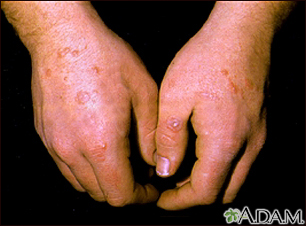
Erythema multiforme on the hands. These lesions are circular and may appear in concentric rings (often called target lesions). They may be associated with other medical conditions such as infections or medications. Cold sores (herpes simplex on the lips) is often associated with this condition.
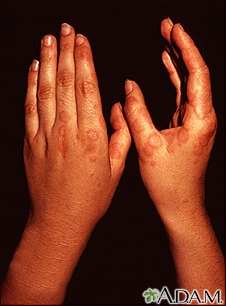
Erythema multiforme lesions are circular and may appear in concentric rings (often called target lesions). Target lesions may also be associated with other medical conditions such as herpes infection, streptococcal infection, tuberculosis (TB), or as a reaction to chemicals or medications.
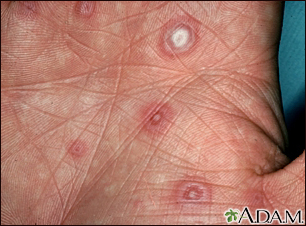
Erythema multiforme lesions are often referred to as target lesions because of the concentric rings the lesions produce. The target appearance is well demonstrated in this photograph.
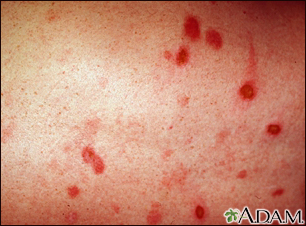
The red spots on this person's back appear where blisters (bullae) caused by Erythema multiforme have ruptured and the overlying skin removed (denuded). The resulting lesions are yellow-crusted ulcers (erosions). Erythema multiforme may be associated with herpes simplex infection, mycoplasma pneumonia, or other medical conditions such as streptococcal infection, tuberculosis (TB), or may result from exposure to chemicals or medications.
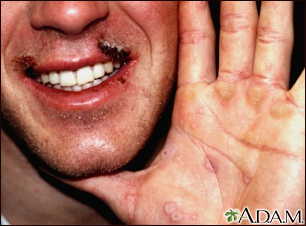
This individual has erythema multiforme minor, with target lesions on his hands. His condition may result from a recurrent herpes simplex virus infection on the lip.
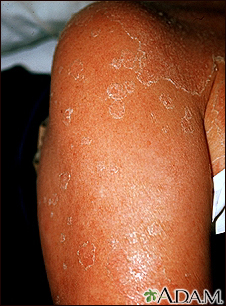
This picture shows diffuse redness (erythema) and scaling on the arm.
Causes
EM is a type of allergic reaction. In most cases, it occurs in response to an infection. In rare cases, it is caused by certain medicines or body-wide (systemic) illness.
Infections that may lead to EM include:
- Viruses, such as herpes simplex virus (HSV) that cause cold sores and genital herpes (most common)
- Bacteria, such as Mycoplasma pneumoniaethat cause lung infection
- Fungi, such as Histoplasma capsulatum, that cause histoplasmosis
Medicines that may cause EM include:
- Nonsteroidal anti-inflammatory drugs (NSAIDs)
- Allopurinol (treats gout)
- Certain antibiotics, such as sulfonamides and aminopenicillins
- Anti-seizure medicines
Systemic illnesses that are associated with EM include:
- Inflammatory bowel disease, such as Crohn disease
- Systemic lupus erythematosus (SLE)
EM occurs mostly in adults 20 to 40 years old. People with EM may have family members who have had EM as well.
Symptoms
Symptoms of EM include:
- Low-grade fever
- Headache
- Sore throat
- Cough
- Runny nose
- General ill feeling
- Itchy skin
- Joint aches
- Many skin lesions (sores or abnormal areas)
The skin rash may:
- Start quickly
- Come back
- Spread
- Be raised or discolored
- Look like hives
- Have a central sore surrounded by pale red rings, also called a target, iris, or bulls-eye
- Have liquid-filled bumps or blisters of various sizes
- Be located on the upper body, legs, arms, palms, hands, or feet
- Include the face or lips
- Appear evenly on both sides of the body (symmetrical)
Other symptoms may include:
- Bloodshot eyes
- Dry eyes
- Eye burning, itching, and discharge
- Eye pain
- Mouth sores
- Vision problems
There are two forms of EM:
- EM minor usually involves the skin and sometimes mouth sores.
- EM major often starts with a fever and joint aches. Besides the skin sores and mouth sores, there may be sores in the eyes, genitals, lung airways, or gut.
Exams and Tests
Your health care provider will look at your skin to diagnose EM. You'll be asked about your medical history, such as recent infections or medicines you've taken.
Tests may include:
- Skin lesion biopsy
- Examination of skin tissue under a microscope
Treatment
EM usually goes away on its own with or without treatment.
Your provider will have you stop taking any medicines that may be causing the problem. But, don't stop taking medicines on your own without talking to your provider first.
Treatment may include:
- Medicines, such as antihistamines, to control itching
- Moist compresses applied to the skin
- Pain medicines to reduce fever and discomfort
- Mouthwashes to ease discomfort of mouth sores that interferes with eating and drinking
- Antibiotics for skin infections
- Corticosteroids to control inflammation
- Medicines for eye symptoms
Good hygiene may help prevent secondary infections (infections that occur from treating the first infection).
Use of sunscreen, protective clothing, and avoiding excessive exposure to sun may prevent the recurrence of EM.
Outlook (Prognosis)
Mild forms of EM usually get better in 2 to 6 weeks, but the problem may return.
Possible Complications
Complications of EM may include:
- Patchy skin color
- Return of EM, especially with HSV infection
When to Contact a Medical Professional
Contact your provider right away if you have symptoms of EM.
References
Duvic M, Chon SY. Urticaria, drug hypersensitivity rashes, nodules and tumors, and atrophic diseases. In: Goldman L, Cooney KA, eds. Goldman-Cecil Medicine. 27th ed. Philadelphia, PA: Elsevier; 2024:chap 407.
Hötzenecker W, Oschmann A, French LE. Erythema multiforme, Stevens-Johnson syndrome, and toxic epidermal necrolysis. In: Bolognia JL, Schaffer JV, Cerroni L, eds. Dermatology. 5th ed. Philadelphia, PA: Elsevier; 2025:chap 20.
Lalor L, Shah KN. Urticaria and erythema multiforme. In: Long SS, ed. Principles and Practice of Pediatric Infectious Diseases. 6th ed. Philadelphia, PA: Elsevier; 2023:chap 71.
Rubenstein JB, Kelly E. Infectious conjunctivitis. In: Yanoff M, Duker JS, eds. Ophthalmology. 5th ed. Philadelphia, PA: Elsevier; 2023:chap 4.6.
Version Info
Last reviewed on: 10/13/2024
Reviewed by: Ramin Fathi, MD, FAAD, Director, Phoenix Surgical Dermatology Group, Phoenix, AZ. Also reviewed by David C. Dugdale, MD, Medical Director, Brenda Conaway, Editorial Director, and the A.D.A.M. Editorial team.
